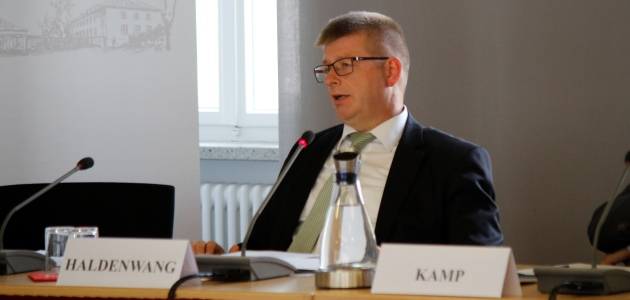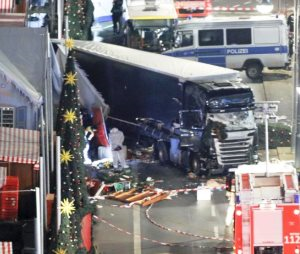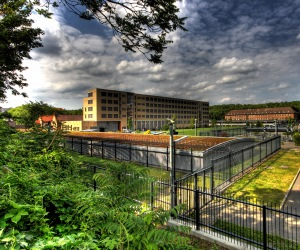At the outset of the module on Internal Security, the Core Course met the President of the Federal Criminal Police Office (BKA), Holger Münch, and the Vice President of the Federal Office for the Protection of the Constitution (BfV), Thomas Haldenwang.

BfV Vice President Haldenwang considered Islamist extremism and terrorism to pose the highest threat potential to the Internal Security of Germany. Picture: BAKS.
Few issues are the subject of such controversial discussion in politics, society, science and the media as the Internal Security of Germany. The Core Course participants were therefore keen on listening to the presentations of the BKA President and the BfV Vice President. BfV Vice President Haldenwang started by saying, "The threat situation develops dynamically." He believed that the main threat to Germany was posed by Islamist extremism and terrorism as a consequence of which an attack had to be expected to happen at any time. According to Mr Haldenwang, who has been working at the BfV since 2009, there are three possible scenarios emerging in this context: Firstly, complex terrorist attacks, such as those that already became a sad reality in Paris in 2015, can happen at any time. He anticipated the danger posed by small groups of terrorists who came to Europe after they had fought in Syria or Iraq. "There is the possibility, especially after the demise of the Islamic State, that these persons return to Germany," the BfV Vice President said. Secondly, there is the danger of lone perpetrators who radicalize themselves and who are very difficult to identify. The radicalization of refugee individuals staying in Germany without prospects was seen as a third hazard scenario by Mr Haldenwang. Alongside Islamist extremism, he also presented figures on violent right- and left-wing extremists.
Islamist Extremism and Terrorism: the highest threat potentials

Terrorist attacks such as the one on Berlin's Breitscheidplatz Christmas market in 2016 can happen again in Germany at any time.
Picture: Karl-Ludwig Poggemann/Flickr/CC BY 2.0.
BKA President Holger Münch also elaborated on the danger of Islamist terrorism. The numbers of potential attackers (called "Gefährder" in German) had grown almost sixfold since 2013. The security authorities adapted to it by making the Joint Counter-Terrorism Center (Gemeinsames Terrorismus-Abwehrzentrum – GTAZ) subject to innovations, among others. By establishing the RADAR-ITE analysis system and the Working Group on Risk Management at the GTAZ, important tools for uniform nationwide standards in dealing with potential attackers and better resource planning had been introduced.
Mr Münch, BKA President since 2014, also addressed the fundamental change digitalization and globalization implied for crime control: Perpetrators increasingly acted across borders and following changing patterns and used state-of-the-art technologies for communicating and committing crimes. This could clearly be felt not only in the field of Islamist terrorism, but also in Organized Crime, and particularly cybercrime. The police had to respond to the resulting challenges and prepare their structures and processes for the future. This notably entailed improvements in the field of international cooperation, innovations in IT infrastructure, a modern leadership and management culture – and, especially, highly qualified, cyber-skilled personnel.

The Joint Counter-Terrorism Center of Germany's federal and state security authorities is situated in Berlin. Picture: Uli Hermann/Wikimedia Commons/CC BY-SA 3.0.
Against the backdrop of the large number of criminal and security challenges facing Germany, both speakers showed the Core Course participants the current capacity to act of the security authorities and, at the same time, dared taking a look ahead to the future. BKA President Münch emphasized that just as the perpetrators' side would develop further, change courses of action and make use of new opportunities for crime, the security authorities should also remain able and willing to learn. Therefore, legal, technical, structural and personnel parameters were needed to be able to keep up with the perpetrators – or better still, to be always one step ahead.
Author: Philipp Fritz
